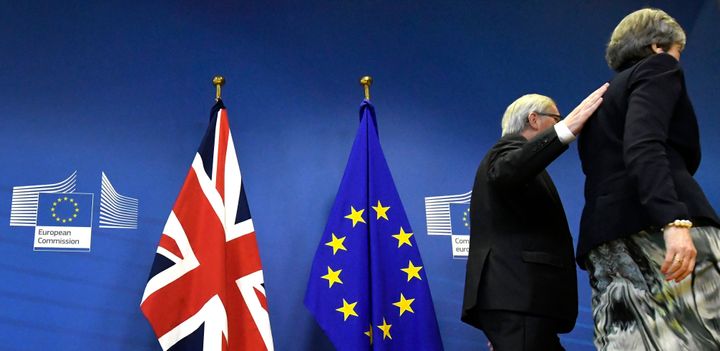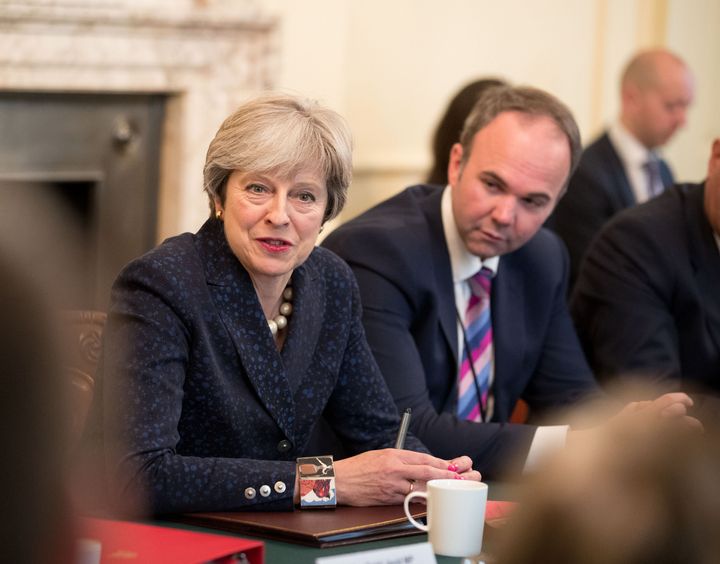In Brussels, as in life, there’s no such thing as a free lunch. Theresa May wants the big prize of the EU finally talking about a post-Brexit trade deal. The cost comes in the shape of hard cash, citizens’ rights and a fudge for Northern Ireland. After a strange day of political anti-climax, the big question remains whether hardline Tory Brexiteers and the DUP think the last of those compromises is a price worth paying.
With so much riding on the outcome, it wasn’t a surprise that there were competing narratives and expectations ahead of the PM’s working lunch with Commission President Jean-Claude Juncker. The day began with Brussels talking up chances of a breakthrough, with one EU official saying both sides were “90% there”. London was much more guarded, insisting the lunch was just a “staging post” and the whole thing could go to the wire of next week’s crunch EU summit.
Less than an hour before both sides broke bread, it looked like the only meal on Theresa May’s menu were several large slices of humble pie. In a market-moving story that electrified Twitter, Irish broadcaster RTE claimed to have a leak of the deal on the vexed issue of Northern Ireland.
Titled ‘the Joint Report from the Commission and the United Kingdom Negotiators on Progress’, the 15-page document was said to include a pledge by the UK of “continued regulatory alignment” between Ulster and the Republic of Ireland. Irish PM Leo Varadkar, who was so relaxed he arrived at his Cabinet meeting dressed originally in his gym gear, said later he had received an assurance that this was the official UK position.
EU council president Donald Tusk displayed his grasp of popular culture by paraphrasing the Boomtown Rats, the Irish rock band which had a British No.1 hit single with ‘I Don’t Like Mondays’. “Tell me why I like Mondays!” Tusk tweeted, breathlessly. “Encouraged after my phone call with Taoiseach @campaignforleo on progress on #Brexit issue of Ireland. Getting closer to sufficient progress at December.”
But some in the DUP had been spooked by the leaks. Irish TV had said one draft of the deal had a commitment that there would be no “regulatory divergence” between Northern Ireland and the Republic of Ireland. Such language is anathema to not just the DUP but their Tory backbench allies. Belgian Green MEP Philippe Lamberts had made things worse when he emerged from a meeting with Juncker to tell the media that the Brits had accepted “reality” and “the pie is almost ready”.
It wasn’t long before the DUP’s Arlene Foster was staging a press conference in Belfast. Reading a carefully worded but typically robust statement: “We will not accept any form of regulatory divergence which separates Northern Ireland economically or politically from the rest of the UK.” May was having lunch, but the DUP couldn’t swallow the meal. Not for the first time, it looked like Ulster was saying ‘No’.

Yet No.10 clearly felt that Ulster could say ‘Yes’ to some kind of compromise. Downing Street had believed the DUP were indeed on board, but it appears that it had made the crucial mistake of not clearing the precise language of “continued regulatory alignment”. The phrase had been deemed strong enough to persuade Dublin there will be no return of a hard border, but weak enough to persuade the DUP that Ulster won’t differ much from the rest of the UK. The second assumption proved less well founded than the first.
Sammy Wilson, one of the DUP’s most hardline Brexiteers, said that even the ‘alignment’ phrasing was “simply EU-speak for keeping Northern Ireland inside the single market and the customs union”. With the SNP’s Nicola Sturgeon and even London Mayor Sadiq Khan saying they wanted a similar deal, Wilson rightly spotted that the huge implications for the rest of the UK. “It’s a Unionist nightmare,” the DUP MP said.
Theresa May had to take a break in the Brussels talks to phone DUP leader Foster to meet her concerns. The two leaders will meet personally, possibly as early as Tuesday. Cynics may suspect both the phone call and the Foster press conference were stunts designed to bolster the DUP’s status. But it turned out the choreography had all been designed for a big announcement of a breakthrough.
Commons Speaker John Bercow let slip in the chamber that he’d been informed the PM would make a statement on Tuesday. I’m told that Government whips had told their Opposition counterparts last week to clear “several hours” for a “major” statement by May. The Irish PM had scheduled a prime time evening live TV press conference to trumpet his victory.

After a lunch lasting three hours, May and Juncker emerged for a teatime press conference. It had been meant to be a celebratory announcement, but ended up being a brief, terse confirmation that the deal was not done. Yet there was more than a hint from the PM that this was a hiccup not a disaster. “Further consultation” was needed on “a couple of issues”, May said.
Unresolved issues on the European Court of Justice, not just on Ulster, were believed to be the stikcing. When the press conference ended, Juncker patted May on the back, a clue that Brussels felt pity for the PM, rather than irritation, over her DUP problem.
No10 were at least cheered that Foster was not categoric in ruling out “regulatory alignment”. The phrase does seem like a classic EU fudge, which can mean different things to different audiences. At his own press conference, Varadkar said “preventing regulatory divergence and maintaining regulatory alignment” were “the same”. The Brits disagree, believing alignment does not mean any hard commitment to a customs union or single market. May also thinks that ‘alignment’ is not about taking EU rules, but the UK deciding which rules it wants.
When Tory MPs gathered in Committee Room 14 in the Commons at 4pm, Brexit minister Steve Baker and May’s chief of staff Gavin Barwell had little concrete to tell them. Yet they did offer reassurance that united both Brexiteers like Jacob Rees-Mogg and Remainers like Anna Soubry: there would be no deal that treated Northern Ireland differently from the rest of the UK.

And this is where the exact phraseology matters. Paragraph 48 of the draft deal – the key section that appeared to have found the magic diplomatic wording of “regulatory alignment” that broke the logjam – explicitly referenced “the protection of the Good Friday Agreement.”
No.10 sources stress that the alignment would only affect EU rules that arise out of the Good Friday Agreement, on limited areas like veterinary practice, the energy market and agriculture. And to avoid any DUP unrest, alignment in those areas would apply to the whole of the UK too. Brexiteer Michael Gove is the Environment Secretary, but he’s also a strong Unionist and May’s gamble will be that he and others accept the deal as the least worst option.
It’s worth remembering that the DUP was one of the few parties that actually pulled out of talks on the Good Friday Agreement when it was being hammered out under the Tony Blair government in 1998. And Arlene Foster was a vehement critic of the peace deal because of its concessions to the IRA.
But as the Northern Ireland peace process itself showed, apparently impossible progress can be made with the right diplomatic wording and sequencing. And the smartest diplomatic deals are the ones that allow both sides to claim victory. May still hopes a deal can be done this week, possibly as early as Wednesday (fresh talks are pencilled in with Juncker for then).
May knows that her fragile grip on the keys to No10 rests on the support of the DUP and on the continued patience of backbench and Cabinet Brexiteers. What unites all sides – Tory Brexiteers, the DUP and EU negotiators - is raw, mutual self-interest. The spectre of two doomsday scenarios hangs over everything: a ‘no deal’ Brexit that harms everyone economically, and the collapse of the May government that will spell yet more instability and delay.
This rollercoaster of a day was reflected neatly by the undulations in the price of sterling on the money markets: when a deal looked imminent, the pound spiked; when May and Junker announced at their terse press conference there was still no deal, the pound plunged.
If a deal is done this week, and formal agreement signed at the EU summit next week, the pound will rise once more. May will then be delighted to have made it to Christmas with diplomatic progress and her Government still intact. Still, she knows more than anyone this is only the first phase of the Brexit talks. The whole point is to buy herself some invaluable time until trade and transition negotiations begin next year.
One devout Leaver joked to me recently that a multi-billion pound Brexit ‘divorce bill’ was worth it because ultimately “freedom isn’t free”. But the trade and transition talks could prove to be much, much more difficult for the PM if her Brexiteers, or the DUP, don’t like what they’re being sold.
